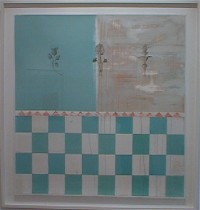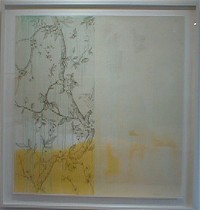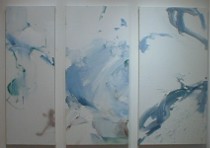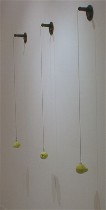
Pentimenti Gallery looks great in its new locale on Second Street. I was passing by a couple of days before the current exhibit opened, and voila, the show was good to go.
Some large paintings and drawing on mylar caught my eye first. The works by Kiki Gaffney, all untitled, reminded me of the interior walls of rowhouses exposed by demolition–rectangular traces of plaster, paint and wallpaper on a shared brick wall.

These pieces, with their beautiful layers of paint, their opacity and translucency, and their graphite wallpaper-pattern drawings seemed to mourn a place that has left just a trace of itself. How appropriate to show these in a gallery named Pentimenti, I thought.
 Sitting in the back of the gallery, working on her artist’s statement, was Peggy Gyulai, whose oils were part of a group called “16 Atmospheres for Paint and Piano,” all painted to classical music. These paintings did capture the atmosphere of their source.
Sitting in the back of the gallery, working on her artist’s statement, was Peggy Gyulai, whose oils were part of a group called “16 Atmospheres for Paint and Piano,” all painted to classical music. These paintings did capture the atmosphere of their source.
For example, the predominantly white triptych with its icy clouds opening to deep space was based on Satie’s “Pieces Froides.” Satie, said Gyulai, was a minimalist with a severe aesthetic whose music influenced minimalist art.
 Gyulai’s other triptych, based on a Debussy piece, had a watery feel, with reflections of skies. It brought to mind a little too literally Monet’s waterlily paintings.
Gyulai’s other triptych, based on a Debussy piece, had a watery feel, with reflections of skies. It brought to mind a little too literally Monet’s waterlily paintings.
The tradition of painting to music always seems to have a number of followers. I’m thinking here of Jeff Waring’s work. But ultimately these paintings, beautiful and rhythmic though they may be, seem more about how they got made than about the final product.
 The third artist showing at Pentimenti was Susanna B. Speirs. I liked the waxy quality and beautiful green-yellow of her pears and the frosty translucency of her branches as well as the swell shadows the objects cast on the wall. I also liked how the pears and branches suggested people. But I’m not sure why they were hanging by wires off some great-looking industrial harware. The work reminded me of people hanging off gibbets–but that’s about all.
The third artist showing at Pentimenti was Susanna B. Speirs. I liked the waxy quality and beautiful green-yellow of her pears and the frosty translucency of her branches as well as the swell shadows the objects cast on the wall. I also liked how the pears and branches suggested people. But I’m not sure why they were hanging by wires off some great-looking industrial harware. The work reminded me of people hanging off gibbets–but that’s about all.









